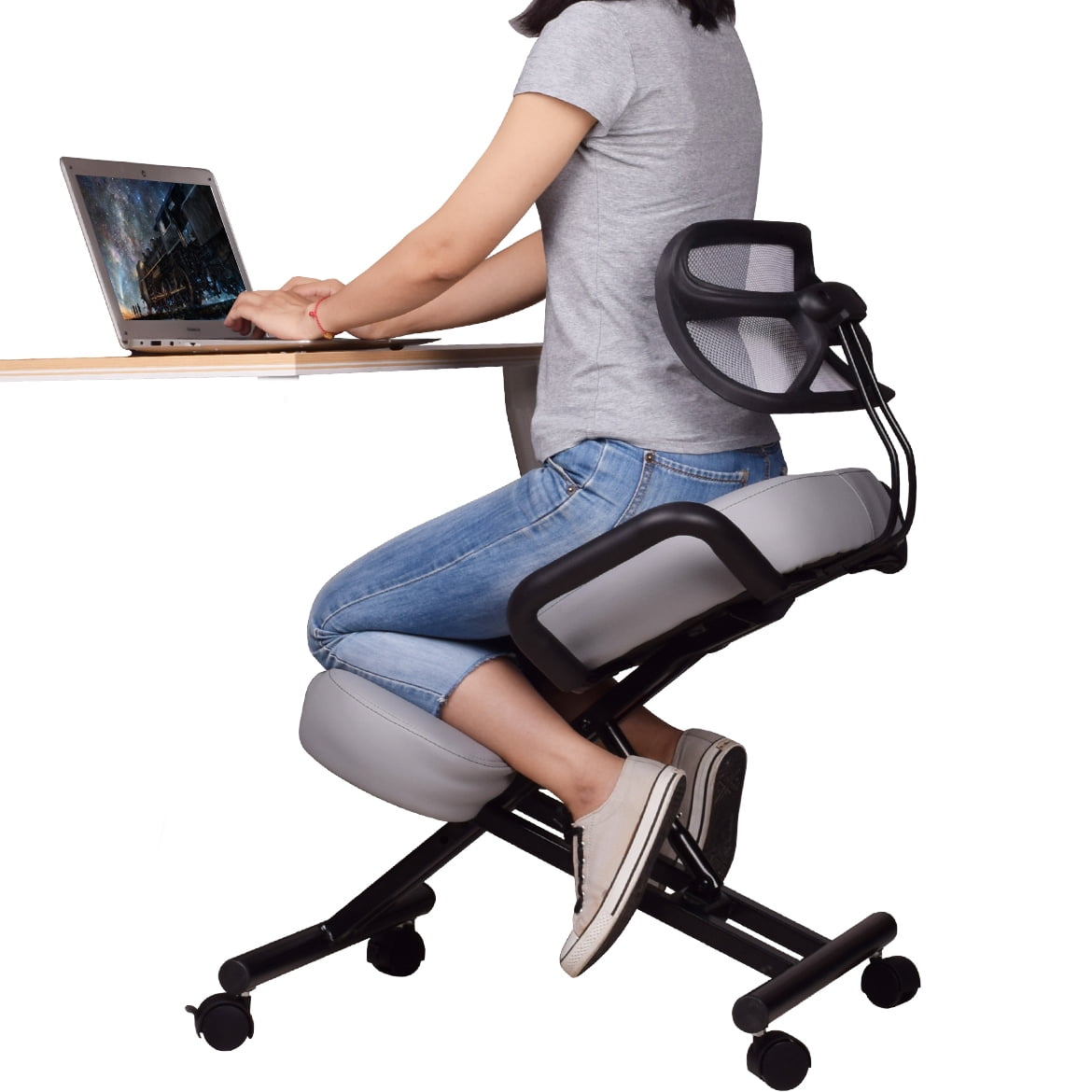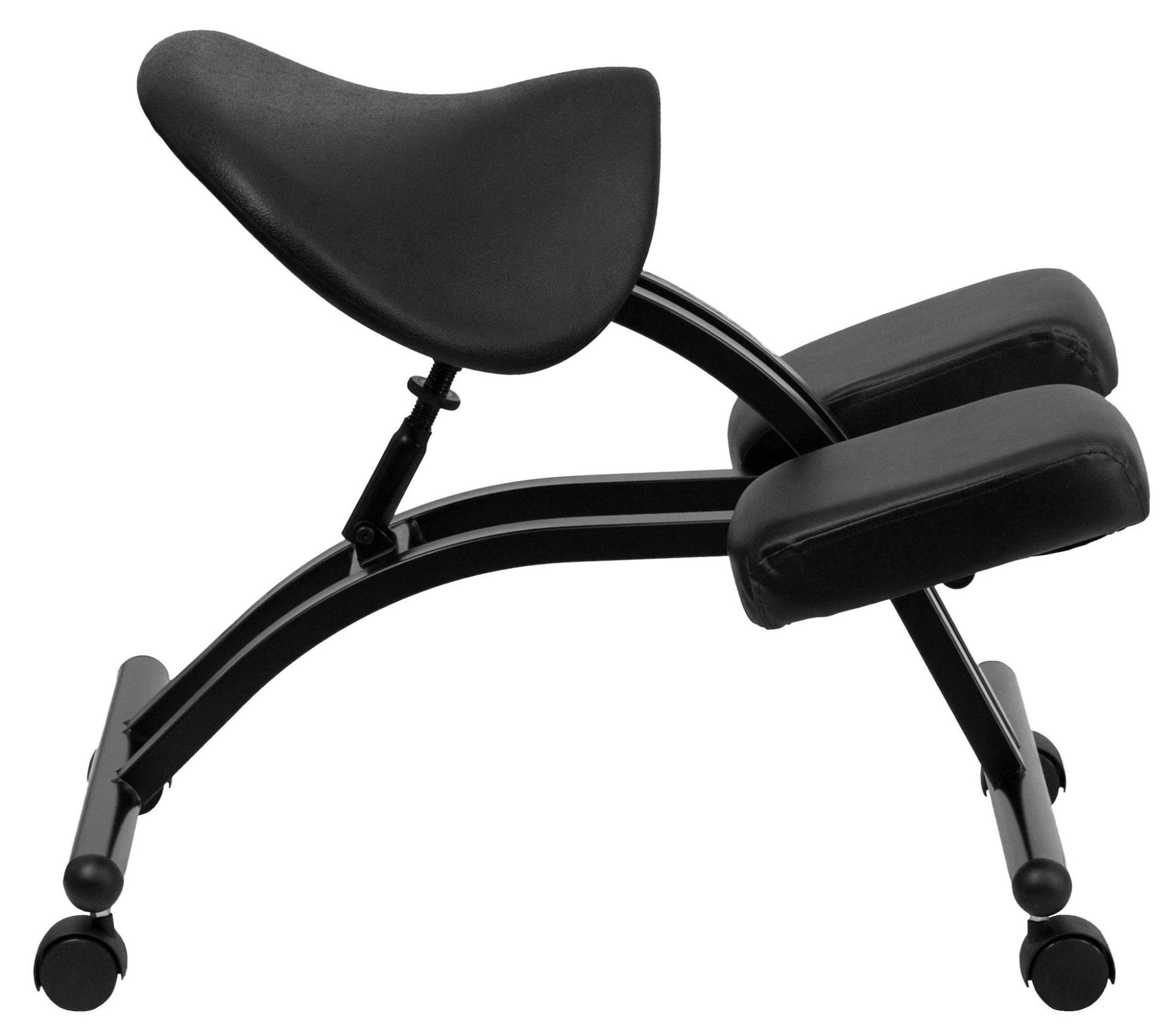Ergonomic Benefits of Kneeling Chairs: Ergonomic Kneeling Chair With Black Saddle Seat

Kneeling chairs, with their distinctive black saddle seats and angled knee pads, offer a unique approach to sitting that can significantly enhance posture and overall comfort. Unlike traditional office chairs, kneeling chairs encourage a more upright and balanced posture, reducing strain on the lower back and promoting better spinal alignment.
Posture and Back Support
Kneeling chairs promote a more natural and ergonomic posture by encouraging a slight forward lean. This forward lean helps to align the spine naturally, reducing stress on the lower back and promoting better posture. The angled knee pads also help to distribute weight evenly across the hips and thighs, reducing pressure on the spine and improving spinal alignment.
Strain Reduction and Spinal Alignment
Sitting in a traditional office chair for extended periods can lead to poor posture, lower back pain, and even spinal disc problems. Kneeling chairs, however, help to alleviate these issues by promoting a more upright posture and reducing the pressure on the lower back. The forward lean encourages the spine to maintain its natural curve, while the knee pads help to distribute weight evenly, reducing strain on the lumbar region.
Comparison to Traditional Office Chairs
Traditional office chairs often lack the necessary support for proper posture and can lead to slouching and discomfort. Kneeling chairs, on the other hand, provide a more ergonomic and supportive seating experience. They encourage a more upright posture, promote better spinal alignment, and reduce strain on the lower back.
Improved Circulation and Reduced Fatigue
Kneeling chairs can also improve circulation and reduce fatigue. The angled knee pads encourage a slight forward lean, which opens up the hips and improves blood flow to the legs. This can help to reduce fatigue and improve overall comfort, especially during long periods of sitting.
Potential Risks and Mitigation
While kneeling chairs offer numerous ergonomic benefits, it is important to be aware of potential risks associated with prolonged kneeling. Prolonged kneeling can put stress on the knees and ankles, and some individuals may experience discomfort or pain. To mitigate these risks, it is important to take regular breaks and to avoid kneeling for extended periods.
It is recommended to use a kneeling chair for a maximum of 4 hours per day and to take regular breaks to stand up and move around.
Features of a Black Saddle Seat Kneeling Chair

A black saddle seat kneeling chair stands out for its unique design and ergonomic benefits. It combines the advantages of a traditional kneeling chair with the added comfort and aesthetics of a saddle seat.
The Saddle Seat Design and Its Impact on Posture
The saddle seat design is a key feature of this type of chair. It encourages an upright, neutral spine position by preventing the user from slouching or leaning forward. The seat’s shape also promotes a more balanced weight distribution, reducing pressure on the lower back and hips. This posture can help alleviate back pain, improve circulation, and enhance core strength.
Advantages of a Black Saddle Seat
A black saddle seat offers both aesthetic and practical benefits. The black color is a classic choice, complementing a wide range of office environments and furniture styles. Black is also known for its durability, resisting stains and scratches, making it a practical choice for everyday use.
Key Features of a High-Quality Ergonomic Kneeling Chair with a Black Saddle Seat
A high-quality ergonomic kneeling chair with a black saddle seat will typically include these features:
- Adjustable Seat Height: This feature allows users to customize the chair’s height to fit their individual body dimensions and ensure proper posture.
- Adjustable Knee Pad Angle: Adjustable knee pads allow users to find the optimal angle for their knees, promoting comfort and reducing pressure on the joints.
- High-Density Foam Padding: The saddle seat should be padded with high-density foam to provide comfort and support during extended periods of sitting.
- Durable Base and Frame: A sturdy base and frame are essential for stability and longevity.
- Easy-to-Clean Materials: The chair’s materials should be easy to clean and maintain, ensuring a hygienic and aesthetically pleasing workspace.
Materials Used for Saddle Seats, Ergonomic kneeling chair with black saddle seat
Saddle seats can be made from various materials, each with its own advantages and disadvantages:
- Leather: Leather is a durable and breathable material that offers a luxurious feel. However, it can be more expensive and requires regular maintenance.
- Vinyl: Vinyl is a cost-effective alternative to leather that is easy to clean and maintain. However, it may not be as breathable or durable as leather.
- Fabric: Fabric saddle seats are comfortable and often come in a wide range of colors and patterns. However, fabric can be prone to staining and may require more frequent cleaning.
Adjustability Options for Kneeling Chairs
In addition to seat height and knee pad angle, high-quality kneeling chairs often offer additional adjustability options:
- Backrest: Some kneeling chairs feature adjustable backrests that provide lumbar support and enhance comfort during extended sitting sessions.
- Armrests: Adjustable armrests can provide additional support and reduce strain on the shoulders and wrists.
Using an Ergonomic Kneeling Chair Effectively

Transitioning to a kneeling chair can be a gradual process. The key is to start slowly and listen to your body’s signals. It’s recommended to begin with short sessions, gradually increasing the time spent on the kneeling chair as you get accustomed to it.
Adjusting and Using a Kneeling Chair
Proper adjustment of the kneeling chair is crucial for optimal comfort and support. Follow these steps:
- Height Adjustment: Adjust the chair’s height so that your thighs are parallel to the floor and your knees are bent at a 90-degree angle. This ensures proper posture and distributes weight evenly.
- Knee Pad Positioning: Ensure the knee pads are positioned comfortably under your shins, allowing for a natural bend in your knees. The knee pads should not be too high or too low, as this can lead to discomfort.
- Seat Angle: Adjust the seat angle to find a comfortable position. It should be slightly tilted forward, encouraging a natural forward lean and supporting your back.
- Backrest: Some kneeling chairs come with a backrest, which can provide additional support. Adjust the backrest to a height that supports your lower back and promotes good posture.
- Footrest: If you feel the need for additional support, use a footrest to elevate your feet slightly. This can help to reduce pressure on your knees and ankles.
Optimal Body Positioning
Maintaining the correct posture is essential for maximizing the benefits of a kneeling chair. Here’s how to achieve optimal positioning:
- Back Straight: Keep your back straight and aligned with your hips. Avoid slouching or hunching over. This promotes good spinal alignment and reduces strain on your back muscles.
- Chin Tucked: Gently tuck your chin towards your chest, ensuring your head is in line with your spine. This helps to maintain a neutral neck position and prevent neck pain.
- Core Engaged: Engage your core muscles to maintain stability and support your back. This will help to prevent fatigue and promote proper posture.
- Weight Distribution: Distribute your weight evenly between your knees and your seat. Avoid leaning too heavily on either the knees or the seat, as this can cause discomfort and strain.
Common Posture Mistakes and Corrections
Here’s a table illustrating common posture mistakes and their corrections when using a kneeling chair:
| Mistake | Correction |
|---|---|
| Slouching or hunching over | Keep your back straight and aligned with your hips. Engage your core muscles to support your posture. |
| Tilting head forward | Gently tuck your chin towards your chest, maintaining a neutral neck position. |
| Leaning too heavily on knees | Distribute your weight evenly between your knees and the seat. Avoid putting excessive pressure on your knees. |
| Sitting too far back on the seat | Adjust the chair’s height so that your thighs are parallel to the floor. This will ensure you are sitting close enough to the seat to maintain good posture. |
Transitioning from a Traditional Chair
- Start Gradually: Begin by using the kneeling chair for short periods, gradually increasing the time as you get used to it. This will help your body adjust to the new posture.
- Listen to Your Body: Pay attention to any discomfort or pain you experience. If you feel any pain, stop using the chair and consult with a healthcare professional.
- Take Breaks: Get up and move around regularly to prevent stiffness and fatigue. Even short breaks can make a big difference.
- Experiment with Adjustments: Adjust the chair’s height, seat angle, and knee pad positioning to find the most comfortable setup for your body.
Sample Workspace Layout
A well-designed workspace can enhance comfort and ergonomics. Here’s a sample layout incorporating a kneeling chair:
- Kneeling Chair Positioning: Place the kneeling chair in a position that allows you to comfortably reach your keyboard, mouse, and monitor. The chair should be positioned close enough to your desk so that your elbows are bent at a 90-degree angle while typing.
- Monitor Height: Adjust the monitor height so that the top of the screen is level with your eyes. This reduces strain on your neck and shoulders.
- Keyboard and Mouse Placement: Position the keyboard and mouse directly in front of you, at a height that allows your wrists to remain straight. Avoid reaching or twisting your wrists, as this can lead to carpal tunnel syndrome.
- Lighting: Ensure adequate lighting in your workspace to reduce eye strain. Use a desk lamp to provide additional light if needed.
- Footrest: If you find that your feet are not resting comfortably on the floor, use a footrest to elevate them slightly. This can help to reduce pressure on your knees and ankles.
Ergonomic kneeling chair with black saddle seat – An ergonomic kneeling chair with a black saddle seat is all about posture and comfort, offering a unique way to sit and work. While not as futuristic as the men in black egg chair , it’s still a statement piece in any home office.
This type of chair encourages a more natural sitting position, promoting better spinal alignment and reducing strain on your back and hips.
An ergonomic kneeling chair with a black saddle seat can be a game-changer for your posture and comfort. But let’s be real, sometimes you just want to add a touch of style to your workspace. That’s where black and white striped chair cushions come in! They’re a classic design element that can instantly elevate the look of your chair, while still keeping things comfortable and stylish.
And let’s face it, a little bit of visual flair never hurt anyone, especially when it comes to your workspace.
